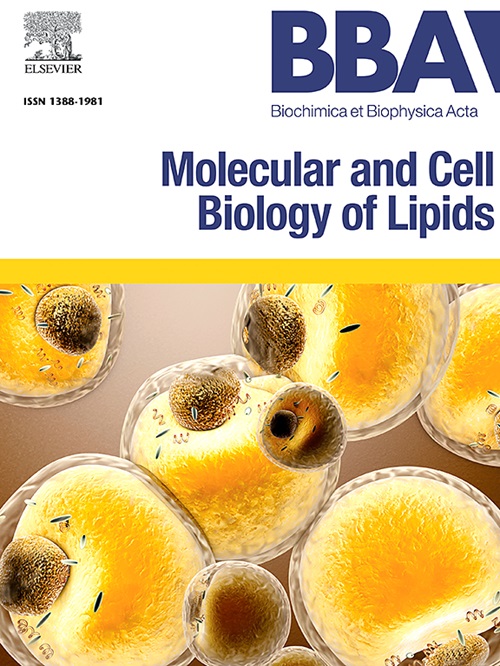α-酮戊二酸对妊娠期砷暴露扰乱的母体脂质稳态和线粒体状态的影响
IF 3.3
2区 生物学
Q2 BIOCHEMISTRY & MOLECULAR BIOLOGY
Biochimica et biophysica acta. Molecular and cell biology of lipids
Pub Date : 2025-07-16
DOI:10.1016/j.bbalip.2025.159665
引用次数: 0
摘要
砷是一种常见的环境毒物,已知具有肝毒性作用,但其对怀孕期间母体脂质代谢的影响仍知之甚少。在这项研究中,我们建立了妊娠小鼠模型,研究妊娠期砷暴露的影响和α-酮戊二酸(α-KG)的潜在保护作用,α-酮戊二酸是三羧酸(TCA)循环的关键中间体。在第一个实验中,砷暴露导致母体血清和肝脏脂质谱的显著破坏。从机制上说,砷降低了肝脏α-KG浓度,破坏了线粒体超微结构,改变了线粒体相关基因表达,诱导氧化应激,减少了多个TCA循环中间体,共同表明线粒体功能受损。在第二个试验中,妊娠期补充α-KG可有效恢复肝脏α-KG水平,逆转砷诱导的脂质代谢失衡。此外,α-KG还能保持线粒体形态,使线粒体基因表达正常化,减轻氧化应激,部分恢复被破坏的TCA中间体水平。这些结果表明,砷主要通过线粒体功能障碍和氧化应激破坏母体脂质稳态,而α-KG的补充可以通过支持线粒体功能来缓解这些干扰。虽然确切的分子机制需要进一步澄清,但我们的研究结果强调了α-KG在维持妊娠期砷暴露期间母体脂质代谢健康方面的潜在治疗作用。本文章由计算机程序翻译,如有差异,请以英文原文为准。

Effect of α-ketoglutarate on maternal lipid homeostasis and mitochondrial status perturbed by gestational arsenic exposure
Arsenic is a common environmental toxicant with known hepatotoxic effects, yet its impact on maternal lipid metabolism during pregnancy remains poorly understood. In this study, we established a pregnant mouse model to investigate the effects of gestational arsenic exposure and the potential protective role of α-ketoglutarate (α-KG), a key tricarboxylic acid (TCA) cycle intermediate. In the first experiment, arsenic exposure led to significant disruptions in maternal serum and hepatic lipid profiles. Mechanistically, arsenic reduced hepatic α-KG concentrations, impaired mitochondrial ultrastructure, altered mitochondria-related gene expression, induced oxidative stress, and decreased multiple TCA cycle intermediates, collectively indicating compromised mitochondrial function. In the second experiment, α-KG supplementation during gestation effectively restored hepatic α-KG levels and reversed arsenic-induced lipid metabolic imbalances. Moreover, α-KG preserved mitochondrial morphology, normalized the expression of mitochondrial genes, alleviated oxidative stress, and partially rescued the levels of disrupted TCA intermediates. These results suggest that arsenic disrupts maternal lipid homeostasis primarily through mitochondrial dysfunction and oxidative stress, and that α-KG supplementation can alleviate these disturbances by supporting mitochondrial function. Although the exact molecular mechanisms require further clarification, our findings highlight the potential therapeutic role of α-KG in maintaining maternal lipid metabolic health during arsenic exposure during pregnancy.
求助全文
通过发布文献求助,成功后即可免费获取论文全文。
去求助
来源期刊
CiteScore
11.00
自引率
2.10%
发文量
109
审稿时长
53 days
期刊介绍:
BBA Molecular and Cell Biology of Lipids publishes papers on original research dealing with novel aspects of molecular genetics related to the lipidome, the biosynthesis of lipids, the role of lipids in cells and whole organisms, the regulation of lipid metabolism and function, and lipidomics in all organisms. Manuscripts should significantly advance the understanding of the molecular mechanisms underlying biological processes in which lipids are involved. Papers detailing novel methodology must report significant biochemical, molecular, or functional insight in the area of lipids.

 求助内容:
求助内容: 应助结果提醒方式:
应助结果提醒方式:


